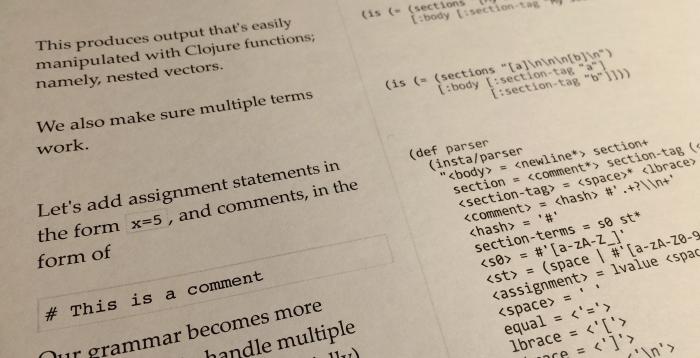Fun with Instaparse
Later: Lazy Physics
Earlier: Nucleotide Repetition Lengths
One of my favorite talks from this month’s excellent Clojure/conj was Carin Meier's presentation, which combined storytelling, live coding, philosophy, the history of computing, and flying robotic drones. She used the relatively new Instaparse library to create her own language to explore something called “Speech Acts” (which I won’t go into here, but do catch the video of her talk when it goes up).
My university work was in physics (and art) rather than CS, but I have long been interested in the implementation of programming languages, even going so far as to write a simple parser for Lisp-style math expressions in Pascal many years ago. Last year I had the opportunity to take the first “write a compiler in Python” class offered by David Beazley here in Chicago, in which we implemented a subset of the Go language. His PLY library is a great way to get started with implementing language parsers in Python, and the relative ease of doing so, compared with classic C implementations described in the infamous Dragon Book, inspired me to do some further experimentation of my own.
With this background, and inspired by Carin’s talk, I have been waiting for an opportunity to try out Instaparse, which is getting great press in the Clojure world. Instaparse takes a grammar as input (in the form of a string), and gives you a parser in the language specified by that grammar. It will also let you specify rules for transforming the resulting tree into something your Clojure program can use more directly (for example, by converting data types or removing unneeded elements from the parse tree).
When the need arose this weekend to read in Python configuration files into a Clojure program, I decided the time was ripe. I also wanted to document the journey using some form of literate programming. A library called Marginalia (Michael Fogus et. al.) made this pretty easy.
The results are on GitHub.
My impressions, after doing this project in just a few hours, are that (1) literate programming is great fun; and (2) Instaparse sets a new standard for power and expressiveness when converting structured text into abstract syntax trees. If you have a DSL or some other text-based, formal language you want to parse, and you are either literate in Clojure or interested in becoming so, Instaparse would be a great tool to check out.
Later: Lazy Physics
Earlier: Nucleotide Repetition Lengths
